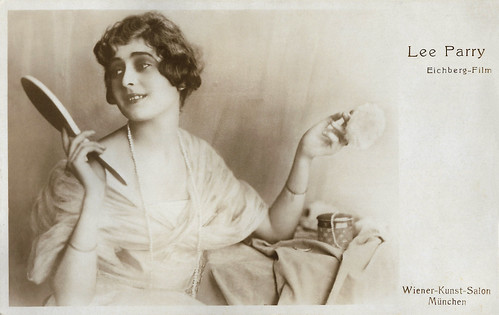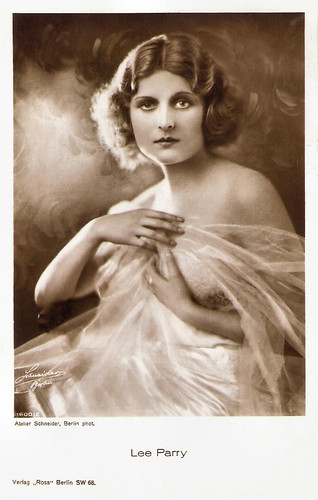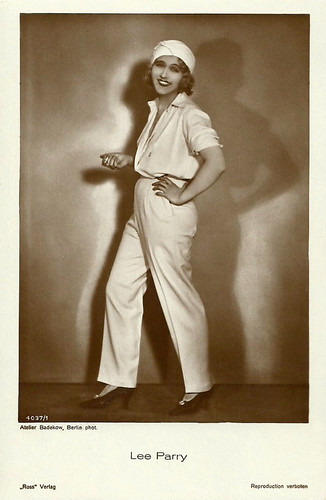Lee Parry (1901-1977) was a German film star of the silent and the early sound era. She appeared in 48 films between 1919 and 1939, often in films directed or produced by her husband Richard Eichberg. In the early 1930s, she sang in Viennese film operettas and made several records.

German postcard by Ross Verlag, no. 458/4, 1919-1924. Photo: Alex Binder.

German postcard by Ross Verlag, no. 1083/1, 1927-1928. Photo: Alex Binder.

German postcard by Ross Verlag, no. 1781/2, 1927-1928. Photo: Alex Binder.

German postcard by Ross Verlag, no. 3106/2, 1928-1929. Photo: Wa-Kie, Berlin.

German postcard by Ross Verlag, no. 4646/1, 1929-1930. Photo: Atelier Balázs, Berlin.
Lee Parry was born Mathilde Charlotte Benz in 1901 in Munich, Germany. She was the daughter of the stage actor, opera tenor, and variety director Josef Friedrich Benz, who was popularly known as 'Papa Benz', and the singer Mathilde Benz.
When she was sixteen, she moved to Berlin. There she was discovered by film director and producer Richard Eichberg. In 1919, she made her debut in Jettatore (Richard Eichberg, 1919) with Aenderly Lebius and Bruno Decarli. Then she played the leading role in Sünden der Eltern/Sins of the Parents (Richard Eichberg, 1919). Eichberg would become her husband.
The following years she starred under the direction of Richard Eichberg in several films for his studio like Nonne und Tänzerin/Nun and Dancer (1919), Hypnose/Hypnosis (1920), and two-parters like Der Tanz auf dem Vulkan/Dance on the Volcano (1920), and Die Fluch der Menschheit/The Curse of Man (1920).
In these films she often appeared opposite Violetta Napierska, Robert Scholz and the young Béla Lugosi. These three actors were again her co-stars in Ihre Hoheit die Tänzerin/Her Highness the Dancer (Richard Eichberg, 1922).
In the historical epic Monna Vanna (Richard Eichberg, 1922), based on a play by Maurice Maeterlinck, her co-star was Paul Wegener, the legendary star of Der Golem/The Golem (Carl Boese, Paul Wegener, 1920). Werner Krauss, famous for his role as Dr. Caligari, was her partner in Fräulein Raffke/Miss Raffke (Richard Eichberg, 1923).

Spanish postcard by La Novela Semanal Cinematográfica, no. 139.

German postcard by Wiener-Kunst-Salon, München (Munich). Photo: Eichberg-Film, Berlin.

French postcard by Cinémagazine Edition, Paris, no. 193.

German postcard by Ross Verlag, no. 458/1, 1919-1924 (at the backside of the card is handwritten: 1920). Photo: Alex Binder.

German postcard by Ross Verlag, Berlin, no. 677/1, 1919-1924. Photo: Gärtner, Berlin / Eichberg-Film.
Lee Parry continued working with Richard Eichberg in hits like Die Motorbraut/The Motor Bride (Richard Eichberg, 1925) and Luxusweibchen/Luxury Wife (Erich Schönfelder, 1925) with Hans Albers. Around that time Parry and Eichberg divorced.
The following year Lee worked for another studio, Maxim-Film/Ebner, and starred in Fedora (Jean Manoussi, 1926) next to Anita Dorris.
For this studio she also featured in Wenn das Herz der Jugend spricht/When the heart of Youth Speaks (Fred Sauer, 1926) opposite Albert Bassermann, Die Frau die nicht nein sagen kann/The Woman Who Can't say No (Fred Sauer, 1927) with Hans Albers, and the comedy Die leichte Isabell/Light Isabell (1927, Eddy Busch, Arthur Wellin) with Gustav Fröhlich.
In France, she appeared in L'eau du Nil/The water of the Nile (Marcel Vandal, 1928), but at the end of the 1920s, her roles became smaller and less frequent.

German postcard by Ross Verlag, Berlin, no. 877/2, 1925-1926. Photo: Heinrich Gärtner, Berlin / Richard Eichberg-Film, Berlin. In 1925, Lee Parry starred in four films, produced by Richard Eichberg-Film with cinematography by Heinrich Gärtner: Die Motorbraut/The Motor Bride (Richard Eichberg, 1925), Luxusweibchen/Luxury Wife (Erich Schönfelder, 1925), Die Frau mit dem Etwas/The woman with something (Erich Schönfelder, 1925), and Der Liebeskäfig/The love cage (Richard Eichberg, Erich Schönfelder, 1925).

German postcard by Ross Verlag, Berlin, no. 1098/1, 1927-1928. Photo: Alex Binder, Berlin. Collection: Didier Hanson.

German postcard by Ross Verlag, Berlin, no. 1599/2, 1927-1928. Photo: Filmhaus Bruckmann & Co. A.-G.

German postcard by Ross Verlag, Berlin, no. 1600/2, 1927-1928. Photo: Atelier Schneider, Berlin.

German postcard by Ross Verlag, no. 1634/1, 1927-1928. Photo: Maxim Film / Bruckmann.
After a hiatus of two years, Lee Parry made her first appearance in a sound film in Die lustigen Weiber von Wien/The Merry Wives of Vienna (Géza von Bolváry, 1931) opposite Willi Forst.
The following year she featured again in three films: the marital-mix-up farce Ein bißchen Liebe für Dich/A Bit of Love (Max Neufeld, 1932) as the wife of Hermann Thimig, the operetta Johann Strauss, k. u. k. Hofkapellmeister/Viennese Waltz (Conrad Wiene, 1932), and another operetta Liebe auf den ersten Ton/Love at First Sight (Carl Froelich, 1932).
In 1933 she starred again in three films, Keinen Tag ohne Dich/No Day Without You (Hans Behrendt, 1933), Der große Bluff/The Big Bluff (Georg Jacoby, 1933) and Die Herren vom Maxim/The Gentlemen from Maxim's (Carl Boese, 1933).
But after this successful year, she would make only two more pictures. After the comedy Das Einmaleins der Liebe/Love's Arithmetic (Carl Hoffmann, 1935) starring Luise Ullrich and Paul Hörbiger, she retired. Shortly before WWII, she appeared in the French production Adieu Vienne/Farewell Vienna (Jacques Séverac, 1939) with Gustav Fröhlich. It would be her last film.
She was also a well-known singer who performed for the radio and made many records including 'Ich bin von Kopf bis Fuß auf Liebe eingestellt' with the orchestra of Theo Mackeben. Her second marriage was to Siegmund Breslauer, director of the German exile theater Freie Deutsche Bühne in Buenos Aires, in 1956, She moved to South-America where she made her theatre comeback as Manon and performed on many stages across South America.
Lee Parry died in Bad Tölz, Germany, in 1977.

German postcard by Ross Verlag, Berlin, no. 1781/3, 1927-1928. Photo: Alex Binder, Berlin.

German postcard by Ross Verlag, Berlin, no. 2070/1, 1927-1928. Photo: National. Harry Liedtke and Lee Parry in Regine, die Tragödie einer Frau/Two Women (Erich Waschneck, 1927).

German postcard by Ross Verlag, no. 3616/1, 1928-1929. Photo: Becker & Maass, Berlin.

German postcard by Ross Verlag, no. 4037/1, 1929-1930. Photo: Atelier Badelkow, Berlin.

German postcard by Ross Verlag, no. 4396/1, 1929-1930. Photo: Bruckmann-Verleih. Lee Parry in Fedora (Jean Manoussi, 1926).

German postcard by Ross Verlag, no. 4646/2, 1929-1930. Photo: Atelier Balàzs, Berlin. Collection: Geoffrey Donaldson Institute.

German postcard by Ross Verlag, no. 5674/1, 1930-1931. Photo: Zander & Labisch, Berlin.

German postcard by Ross Verlag, no. 6784/1, 1931-1932. Photo: Atelier Schneider, Berlin. Collection: Didier Hanson.

German postcard by Ross Verlag, Berlin, no. 7169/1, 1932-1933. Photo: Splendid-Film.

Dutch postcard by JosPe, no. 425. Photo: Filma.
Sources: I.S.Mowis (IMDb), Thomas Staedeli (Cyranos), Wikipedia, AllMovie, and IMDb.
This post was last updated on 28 June 2020.

German postcard by Ross Verlag, no. 458/4, 1919-1924. Photo: Alex Binder.

German postcard by Ross Verlag, no. 1083/1, 1927-1928. Photo: Alex Binder.

German postcard by Ross Verlag, no. 1781/2, 1927-1928. Photo: Alex Binder.

German postcard by Ross Verlag, no. 3106/2, 1928-1929. Photo: Wa-Kie, Berlin.

German postcard by Ross Verlag, no. 4646/1, 1929-1930. Photo: Atelier Balázs, Berlin.
Dr. Caligari, the Golem and Dracula
Lee Parry was born Mathilde Charlotte Benz in 1901 in Munich, Germany. She was the daughter of the stage actor, opera tenor, and variety director Josef Friedrich Benz, who was popularly known as 'Papa Benz', and the singer Mathilde Benz.
When she was sixteen, she moved to Berlin. There she was discovered by film director and producer Richard Eichberg. In 1919, she made her debut in Jettatore (Richard Eichberg, 1919) with Aenderly Lebius and Bruno Decarli. Then she played the leading role in Sünden der Eltern/Sins of the Parents (Richard Eichberg, 1919). Eichberg would become her husband.
The following years she starred under the direction of Richard Eichberg in several films for his studio like Nonne und Tänzerin/Nun and Dancer (1919), Hypnose/Hypnosis (1920), and two-parters like Der Tanz auf dem Vulkan/Dance on the Volcano (1920), and Die Fluch der Menschheit/The Curse of Man (1920).
In these films she often appeared opposite Violetta Napierska, Robert Scholz and the young Béla Lugosi. These three actors were again her co-stars in Ihre Hoheit die Tänzerin/Her Highness the Dancer (Richard Eichberg, 1922).
In the historical epic Monna Vanna (Richard Eichberg, 1922), based on a play by Maurice Maeterlinck, her co-star was Paul Wegener, the legendary star of Der Golem/The Golem (Carl Boese, Paul Wegener, 1920). Werner Krauss, famous for his role as Dr. Caligari, was her partner in Fräulein Raffke/Miss Raffke (Richard Eichberg, 1923).

Spanish postcard by La Novela Semanal Cinematográfica, no. 139.

German postcard by Wiener-Kunst-Salon, München (Munich). Photo: Eichberg-Film, Berlin.

French postcard by Cinémagazine Edition, Paris, no. 193.

German postcard by Ross Verlag, no. 458/1, 1919-1924 (at the backside of the card is handwritten: 1920). Photo: Alex Binder.

German postcard by Ross Verlag, Berlin, no. 677/1, 1919-1924. Photo: Gärtner, Berlin / Eichberg-Film.
Divorce from Richard Eichberg
Lee Parry continued working with Richard Eichberg in hits like Die Motorbraut/The Motor Bride (Richard Eichberg, 1925) and Luxusweibchen/Luxury Wife (Erich Schönfelder, 1925) with Hans Albers. Around that time Parry and Eichberg divorced.
The following year Lee worked for another studio, Maxim-Film/Ebner, and starred in Fedora (Jean Manoussi, 1926) next to Anita Dorris.
For this studio she also featured in Wenn das Herz der Jugend spricht/When the heart of Youth Speaks (Fred Sauer, 1926) opposite Albert Bassermann, Die Frau die nicht nein sagen kann/The Woman Who Can't say No (Fred Sauer, 1927) with Hans Albers, and the comedy Die leichte Isabell/Light Isabell (1927, Eddy Busch, Arthur Wellin) with Gustav Fröhlich.
In France, she appeared in L'eau du Nil/The water of the Nile (Marcel Vandal, 1928), but at the end of the 1920s, her roles became smaller and less frequent.

German postcard by Ross Verlag, Berlin, no. 877/2, 1925-1926. Photo: Heinrich Gärtner, Berlin / Richard Eichberg-Film, Berlin. In 1925, Lee Parry starred in four films, produced by Richard Eichberg-Film with cinematography by Heinrich Gärtner: Die Motorbraut/The Motor Bride (Richard Eichberg, 1925), Luxusweibchen/Luxury Wife (Erich Schönfelder, 1925), Die Frau mit dem Etwas/The woman with something (Erich Schönfelder, 1925), and Der Liebeskäfig/The love cage (Richard Eichberg, Erich Schönfelder, 1925).

German postcard by Ross Verlag, Berlin, no. 1098/1, 1927-1928. Photo: Alex Binder, Berlin. Collection: Didier Hanson.

German postcard by Ross Verlag, Berlin, no. 1599/2, 1927-1928. Photo: Filmhaus Bruckmann & Co. A.-G.

German postcard by Ross Verlag, Berlin, no. 1600/2, 1927-1928. Photo: Atelier Schneider, Berlin.

German postcard by Ross Verlag, no. 1634/1, 1927-1928. Photo: Maxim Film / Bruckmann.
Come-back in Viennese operettas
After a hiatus of two years, Lee Parry made her first appearance in a sound film in Die lustigen Weiber von Wien/The Merry Wives of Vienna (Géza von Bolváry, 1931) opposite Willi Forst.
The following year she featured again in three films: the marital-mix-up farce Ein bißchen Liebe für Dich/A Bit of Love (Max Neufeld, 1932) as the wife of Hermann Thimig, the operetta Johann Strauss, k. u. k. Hofkapellmeister/Viennese Waltz (Conrad Wiene, 1932), and another operetta Liebe auf den ersten Ton/Love at First Sight (Carl Froelich, 1932).
In 1933 she starred again in three films, Keinen Tag ohne Dich/No Day Without You (Hans Behrendt, 1933), Der große Bluff/The Big Bluff (Georg Jacoby, 1933) and Die Herren vom Maxim/The Gentlemen from Maxim's (Carl Boese, 1933).
But after this successful year, she would make only two more pictures. After the comedy Das Einmaleins der Liebe/Love's Arithmetic (Carl Hoffmann, 1935) starring Luise Ullrich and Paul Hörbiger, she retired. Shortly before WWII, she appeared in the French production Adieu Vienne/Farewell Vienna (Jacques Séverac, 1939) with Gustav Fröhlich. It would be her last film.
She was also a well-known singer who performed for the radio and made many records including 'Ich bin von Kopf bis Fuß auf Liebe eingestellt' with the orchestra of Theo Mackeben. Her second marriage was to Siegmund Breslauer, director of the German exile theater Freie Deutsche Bühne in Buenos Aires, in 1956, She moved to South-America where she made her theatre comeback as Manon and performed on many stages across South America.
Lee Parry died in Bad Tölz, Germany, in 1977.

German postcard by Ross Verlag, Berlin, no. 1781/3, 1927-1928. Photo: Alex Binder, Berlin.

German postcard by Ross Verlag, Berlin, no. 2070/1, 1927-1928. Photo: National. Harry Liedtke and Lee Parry in Regine, die Tragödie einer Frau/Two Women (Erich Waschneck, 1927).

German postcard by Ross Verlag, no. 3616/1, 1928-1929. Photo: Becker & Maass, Berlin.

German postcard by Ross Verlag, no. 4037/1, 1929-1930. Photo: Atelier Badelkow, Berlin.

German postcard by Ross Verlag, no. 4396/1, 1929-1930. Photo: Bruckmann-Verleih. Lee Parry in Fedora (Jean Manoussi, 1926).

German postcard by Ross Verlag, no. 4646/2, 1929-1930. Photo: Atelier Balàzs, Berlin. Collection: Geoffrey Donaldson Institute.

German postcard by Ross Verlag, no. 5674/1, 1930-1931. Photo: Zander & Labisch, Berlin.

German postcard by Ross Verlag, no. 6784/1, 1931-1932. Photo: Atelier Schneider, Berlin. Collection: Didier Hanson.

German postcard by Ross Verlag, Berlin, no. 7169/1, 1932-1933. Photo: Splendid-Film.

Dutch postcard by JosPe, no. 425. Photo: Filma.
Sources: I.S.Mowis (IMDb), Thomas Staedeli (Cyranos), Wikipedia, AllMovie, and IMDb.
This post was last updated on 28 June 2020.
No comments:
Post a Comment